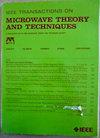A Compact 24–30-GHz GaN Front-End Module With Coupled-Resonator-Based Transmit/Receive Switch for 5G Millimeter-Wave Applications
IF 4.1
1区 工程技术
Q2 ENGINEERING, ELECTRICAL & ELECTRONIC
IEEE Transactions on Microwave Theory and Techniques
Pub Date : 2025-01-29
DOI:10.1109/TMTT.2025.3530435
引用次数: 0
Abstract
This article presents a wideband front-end module (FEM) topology with integrated transmit/receive (T/R) switch utilizing a matching network (MN) reuse technique. The output MN (OMN) of the power amplifier (PA) and the input MN (IMN) of the low noise amplifier (LNA) are reused in the switch network co-design, enabling T/R switching and impedance transformation simultaneously. In TX mode, a switchless MN incorporating RX reactance is employed to improve the output power and efficiency. In RX mode, the OMN of the PA serves as an extra resonant tank and can be absorbed into the RX MN to enhance RX bandwidth and noise performance. To validate the proposed FEM topology, we implemented a 24–30-GHz FEM for 5G millimeter-wave (mmWave) applications using a commercial 0.15-求助全文
约1分钟内获得全文
求助全文
来源期刊

IEEE Transactions on Microwave Theory and Techniques
工程技术-工程:电子与电气
CiteScore
8.60
自引率
18.60%
发文量
486
审稿时长
6 months
期刊介绍:
The IEEE Transactions on Microwave Theory and Techniques focuses on that part of engineering and theory associated with microwave/millimeter-wave components, devices, circuits, and systems involving the generation, modulation, demodulation, control, transmission, and detection of microwave signals. This includes scientific, technical, and industrial, activities. Microwave theory and techniques relates to electromagnetic waves usually in the frequency region between a few MHz and a THz; other spectral regions and wave types are included within the scope of the Society whenever basic microwave theory and techniques can yield useful results. Generally, this occurs in the theory of wave propagation in structures with dimensions comparable to a wavelength, and in the related techniques for analysis and design.
 求助内容:
求助内容: 应助结果提醒方式:
应助结果提醒方式:


